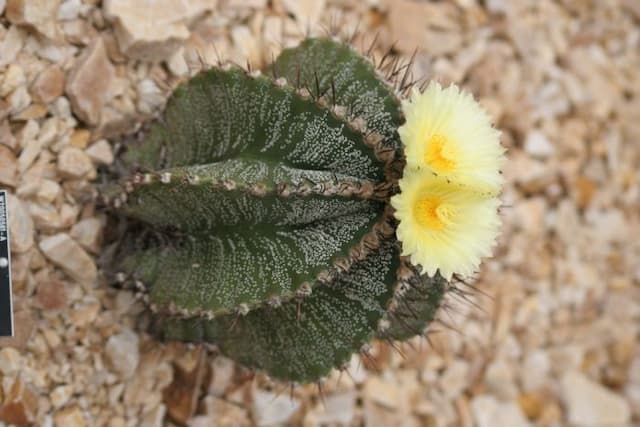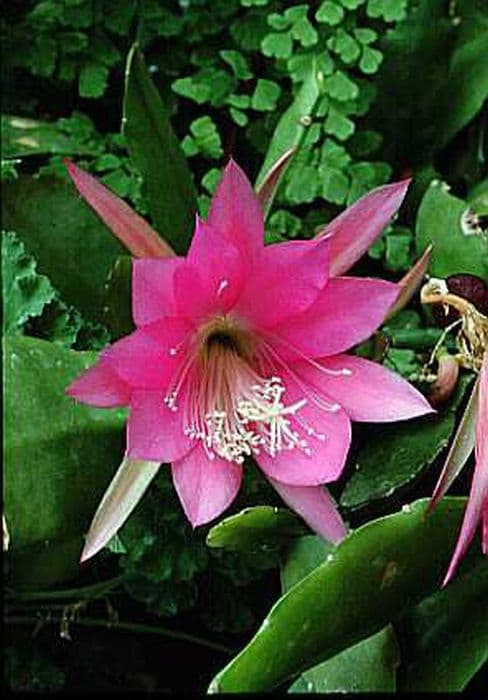Crown Cactus Rebutia steinbachii subsp. steinbachii

ABOUT
Rebutia steinbachii subsp. steinbachii, commonly known as the Crown Cactus, is a small, globe-shaped succulent that features a clustering habit. Its body is composed of bright green, fleshy segments that are heavily ribbed with numerous small bumps, or tubercles, from which spines emerge. Each tubercle on the Crown Cactus displays a woolly areole at its tip that produces several spines. These spines can range in color from white to golden yellow, and they form a dense halo around each segment. The appearance of the spines can give the plant a somewhat shaggy look. The Crown Cactus is also known for its vibrant flowers, which bloom in a circular pattern right at the plant's crown. The flowers display a rich, saturated color, usually in shades of red, orange, pink, or yellow, and feature a funnel shape. The petals are narrow at the base and spread out wide at the tips, giving the blooms a delicate and striking contrast against the spiny body of the plant. The bright blossoms can be quite showy and typically appear during the spring and summer months. Overall, the Crown Cactus presents a charming and colorful display, which makes it a popular choice among cactus enthusiasts and gardeners looking to add a touch of exotic beauty to their collections or rock gardens. Despite its ornamental spines and stunning flowers, it maintains a compact form, suitable for small spaces where a touch of the desert's allure is desired.
About this plant
 Names
NamesFamily
Cactaceae.
Synonyms
Steinbach's Crown Cactus, Orange Crown Cactus.
Common names
Rebutia steinbachii, Mediolobivia steinbachii.
 Toxicity
ToxicityTo humans
Rebutia steinbachii subsp. steinbachii, commonly known as the Crown Cactus, is not known to be toxic to humans. There is no commonly reported toxicity from ingesting or coming into contact with this plant, so it is generally considered safe in homes and gardens. However, like with any plant, it is always a good idea to exercise caution and avoid ingesting parts of ornamental plants as they are not intended for consumption.
To pets
The Crown Cactus is not known to be toxic to pets. There is no evidence to suggest that ingestion of this cactus by pets, such as cats or dogs, leads to poisoning. Consequently, this plant is considered non-toxic to pets. However, the spines on cacti can cause physical injury if a pet tries to chew on or swallow the plant, so it is still best to keep this and other spiny plants out of reach of curious pets.
 Characteristics
CharacteristicsLife cycle
Perennials
Foliage type
Evergreen
Color of leaves
Green
Flower color
Varies
Height
0.5 feet (15 centimeters)
Spread
0.5 feet (15 centimeters)
Plant type
Cactus
Hardiness zones
9
Native area
Bolivia
Benefits
 General Benefits
General Benefits- Aesthetic Appeal: Rebutia steinbachii, commonly known as Steinbach's crown cactus, adds visual interest to any space with its bright flowers and compact, round shape.
- Easy to Care: Being a cactus, it is low-maintenance, requiring minimal water and care, making it ideal for busy plant enthusiasts or beginners.
- Drought Tolerance: Due to its drought-tolerant nature, it conserves water and thrives in arid conditions, reducing the need for frequent watering.
- Adaptability: Steinbach's crown cactus is adaptable to various soil types as long as they are well-draining, providing flexibility in planting locations.
- Compact Size: Its small size makes it perfect for windowsills, desks, and small spaces where larger plants wouldn't fit.
- Propagation Ease: This plant can be easily propagated from offsets, allowing enthusiasts to share and spread the joy of planting.
 Medical Properties
Medical PropertiesThis plant is not used for medical purposes.
 Air-purifying Qualities
Air-purifying QualitiesThis plant is not specifically known for air purifying qualities.
 Other Uses
Other Uses- Rebutia steinbachii, commonly known as crown cactus, is often used in succulent gardens for its compact size and ability to fit into small spaces.
- The crown cactus can be used in terrariums due to its minimal water requirements and small root system.
- This species can serve as a living educational tool for teaching children about plant care and the native habitats of cacti.
- The bright flowers of the crown cactus can be used to add a pop of color to miniature rock or desert gardens.
- Rebutia steinbachii can be gifted as a symbol of resilience and endurance, given its ability to thrive in harsh conditions.
- This cactus can be employed in photography and art projects due to its visually appealing structure and symmetry.
- The plant can be used as a natural barrier to create divisions within a drought-resistant landscape design.
- Crown cactus is incorporated into xeriscaping – landscaping designed to reduce or eliminate the need for irrigation.
- Rebutia steinbachii can be used as a means to practice grafting techniques by combining it with other cacti.
- Hobbyists may collect this cactus as a part of a larger collection focusing on Bolivian or Andean flora.
Interesting Facts
 Feng Shui
Feng ShuiThe Crown cactus is not used in Feng Shui practice.
 Zodiac Sign Compitability
Zodiac Sign CompitabilityThe Crown cactus is not used in astrology practice.
 Plant Symbolism
Plant Symbolism- Resilience: Known also as the Crown Cactus, Rebutia steinbachii subsp. steinbachii thrives in rocky mountain regions, symbolizing the ability to endure challenging conditions and adaptability to harsh environments.
- Beauty in Small Packages: As a petite flowering cactus, the Crown Cactus represents the idea that beauty and vibrancy can come in small, unexpected forms.
- Joy and Cheerfulness: With its bright, colorful blooms, this cactus embodies happiness and the bringing of joy to one's surroundings, much like a crown brings attention to its bearer.
- Protection: Cacti in general are associated with protection due to their spines, and the Crown Cactus is no exception, symbolizing safeguarding and defense against threats.
 Water
WaterCrown Cactus (Rebutia steinbachii subsp. steinbachii) requires careful watering to avoid over-saturation. During the active growth season, typically spring and summer, water the plant thoroughly once the soil has completely dried out, which may be approximately once a week, but frequency can vary depending on environmental conditions. Use enough water so that it runs out of the pot's drainage holes, which might equate to around 8-16 ounces depending on pot size. Reduce watering in the fall and to a minimum in the winter, providing just enough to prevent the soil from completely drying out, possibly reducing to once a month.
 Light
LightCrown Cactus thrives in bright, indirect sunlight but can also tolerate direct sun in the morning or late afternoon. Avoid harsh midday sun which can scorch the plant. A south-facing window with some shade or an east-west facing window would usually provide ideal lighting conditions for this cactus.
 Temperature
TemperatureThe Crown Cactus prefers moderate temperatures, ideally between 70°F and 80°F during the active growing season. It can endure temperatures as low as 50°F during its dormancy in winter, but should not be exposed to temperatures below 40°F to prevent damage. These temperature ranges support healthy growth and blooming.
 Pruning
PruningPruning is generally not necessary for the Crown Cactus as its growth habit does not tend to become unruly. However, any dead or damaged spines can be gently removed to keep the plant looking tidy. The best time to prune, if necessary, would be in the late winter before new growth begins in the spring.
 Cleaning
CleaningAs needed
 Soil
SoilHedgehog Cactus requires a well-draining soil mix with a pH range of about 6.0 to 7.5. A mix of 50% potting soil, 25% sand, and 25% perlite or pumice is ideal to ensure proper drainage and aeration.
 Repotting
RepottingHedgehog Cactus should be repotted every 2-3 years or when the plant has outgrown its current pot, to provide fresh nutrients and prevent root-bound conditions.
 Humidity & Misting
Humidity & MistingHedgehog Cactus thrives in low humidity conditions, typical of arid environments, avoiding high humidity to prevent rot and fungal infections.
 Suitable locations
Suitable locationsIndoor
Place in bright, indirect light and well-draining soil.
Outdoor
Ensure full sun to part shade and protect from heavy rain.
Hardiness zone
5-11 USDA
 Life cycle
Life cycleThe life cycle of Rebutia steinbachii subsp. steinbachii, commonly known as Steinbach's Crown Cactus, starts with seed germination, which requires warm temperatures and moist, well-draining soil. Seedlings develop into juvenile plants with small, globular stems covered in spines, and over time, they mature into adult cacti with more pronounced, densely packed spines and vibrant flowers that bloom primarily in the spring. After pollination, often by insects, fruits form that contain seeds, thus completing the reproductive cycle. Over many years, the plant may produce offsets or "pups" around its base, which can be separated to propagate new plants. Periods of dormancy are common during colder, less active growth months, and with proper care, the cactus can live for several decades.
 Propogation
PropogationPropogation time
Spring to Summer
The Crown Cactus, scientifically known as Rebutia steinbachii subsp. steinbachii, is often propagated through the means of seed or by separating offsets. The most popular method is through the removal of offsets which are the small cacti that form at the base of the parent plant. This can typically be done during the warmer months, spring through early autumn, when the plant is actively growing. To propagate by offsets, one must carefully remove an offset with a clean, sharp knife, ensuring a portion of the root is attached if possible. Allow the offset to dry for a few days to form a callous over the cut surface to prevent infection. Once calloused, plant the offset in a cactus potting mix, placing it in a bright area without direct sunlight and water sparingly, just enough to keep the mix slightly moist. Rooting usually occurs within a few weeks, after which normal cactus care can resume.









